engine Mercury Mountaineer 1997 s Owner's Guide
[x] Cancel search | Manufacturer: MERCURY, Model Year: 1997, Model line: Mountaineer, Model: Mercury Mountaineer 1997Pages: 197, PDF Size: 2.08 MB
Page 137 of 197

come on unexpectedly; always
turn the engine off and let it
cool.
The cooling fan is
automatic and may come
on at any time. Always
disconnect the negative terminal
of the battery before working
near the fan.
²Never get under a vehicle
supported only by a jack. If you
must work under a vehicle, use
safety stands.
²Keep all lit cigarettes and other
smoking materials away from
the battery and all fuel-related
parts.
Working with the engine off
1. Set the parking brake and make
sure that the gearshift is securely
latched in P (Park).
2. Turn the engine off and remove
the key from the ignition.
3. Block the wheels to prevent the
vehicle from moving unexpectedly.
0020406080100
120
140
160
180
200P RND21
000000oooo
MPH km/h
UNLEADED
FUEL ONLY
RPM x 100012345
6H
C
F
E
RSM
SET
ACC
COAST OFF ON
SRS
- +H
H
L L
Maintenance and care
137
Page 138 of 197

Working with the engine on
1. Set the parking brake and make
sure that the gearshift is securely
latched in P (Park).
2. Do not work on a vehicle in an
enclosed space with the engine
running.
3. Block the wheels to prevent the
vehicle from moving unexpectedly.
4. If work must be done with the
engine running, avoid wearing
loose clothing or jewelry that could
get caught in moving parts. Take
appropriate precautions with long
hair.
Opening the hood
1. Inside the vehicle, pull the hood
release handle located under the
steering column.
2. While applying downward
pressure on the hood, push the
hood latch handle located behind
the grille near the center front of
the vehicle to the left.
3. Lift the hood.
After closing the hood, try to lift it
to be sure that it is closed
securely.
Lubricate the hood latch every six
months to ensure proper
operation.
0020406080100
120
140
160
180
200P RND21
000000oooo
MPH km/h
UNLEADED
FUEL ONLY
RPM x 100012345
6H
C
F
E
RSM
SET
ACC
COAST OFF ON
SRS
- +H
H
L L
Maintenance and care
138
Page 139 of 197
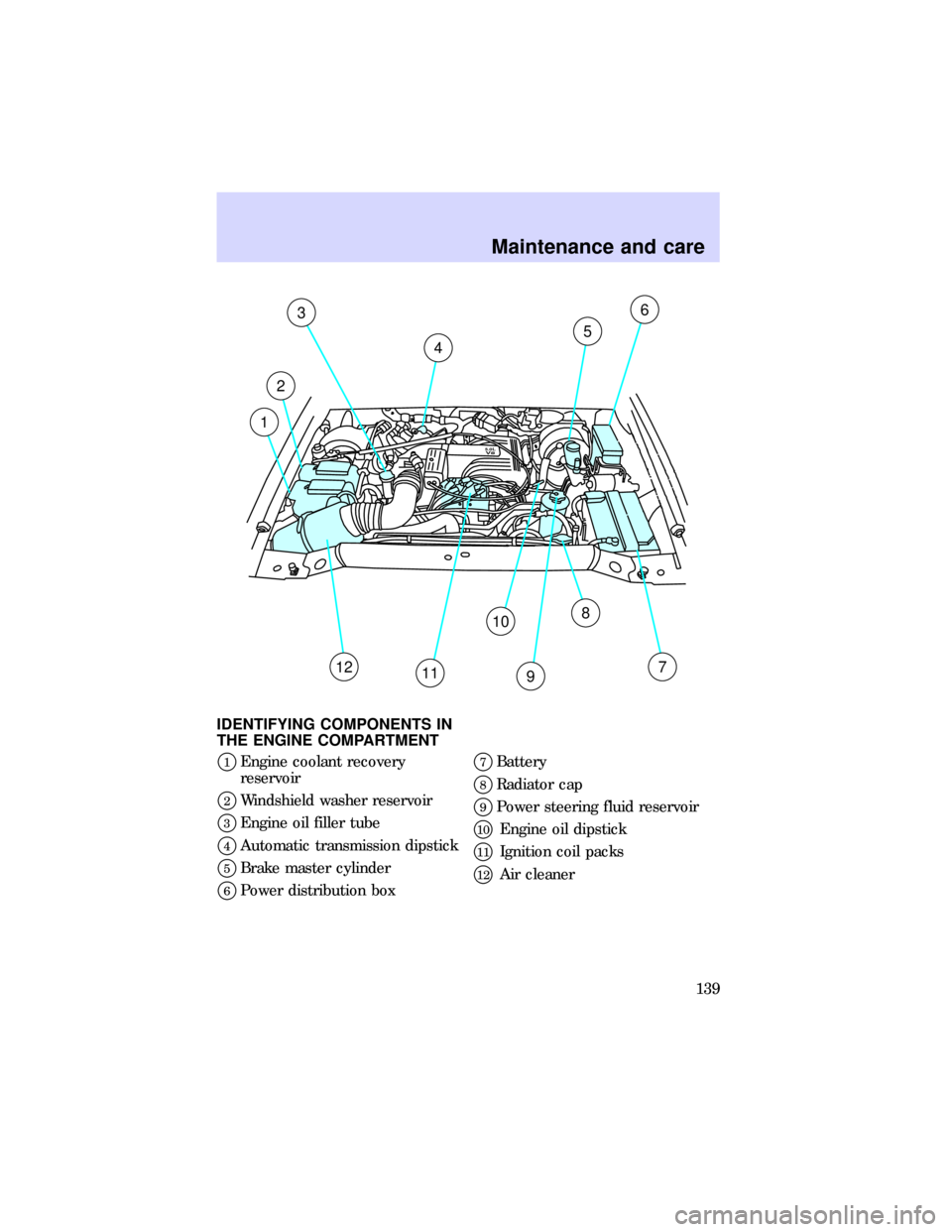
IDENTIFYING COMPONENTS IN
THE ENGINE COMPARTMENT
V1Engine coolant recovery
reservoir
V2Windshield washer reservoir
V3Engine oil filler tube
V4Automatic transmission dipstick
V5Brake master cylinder
V6Power distribution box
V7Battery
V8Radiator cap
V9Power steering fluid reservoir
V10Engine oil dipstick
V11Ignition coil packs
V12Air cleaner
3
4
5
6
2
1
1211
108
79
5.0L
V8
Maintenance and care
139
Page 140 of 197
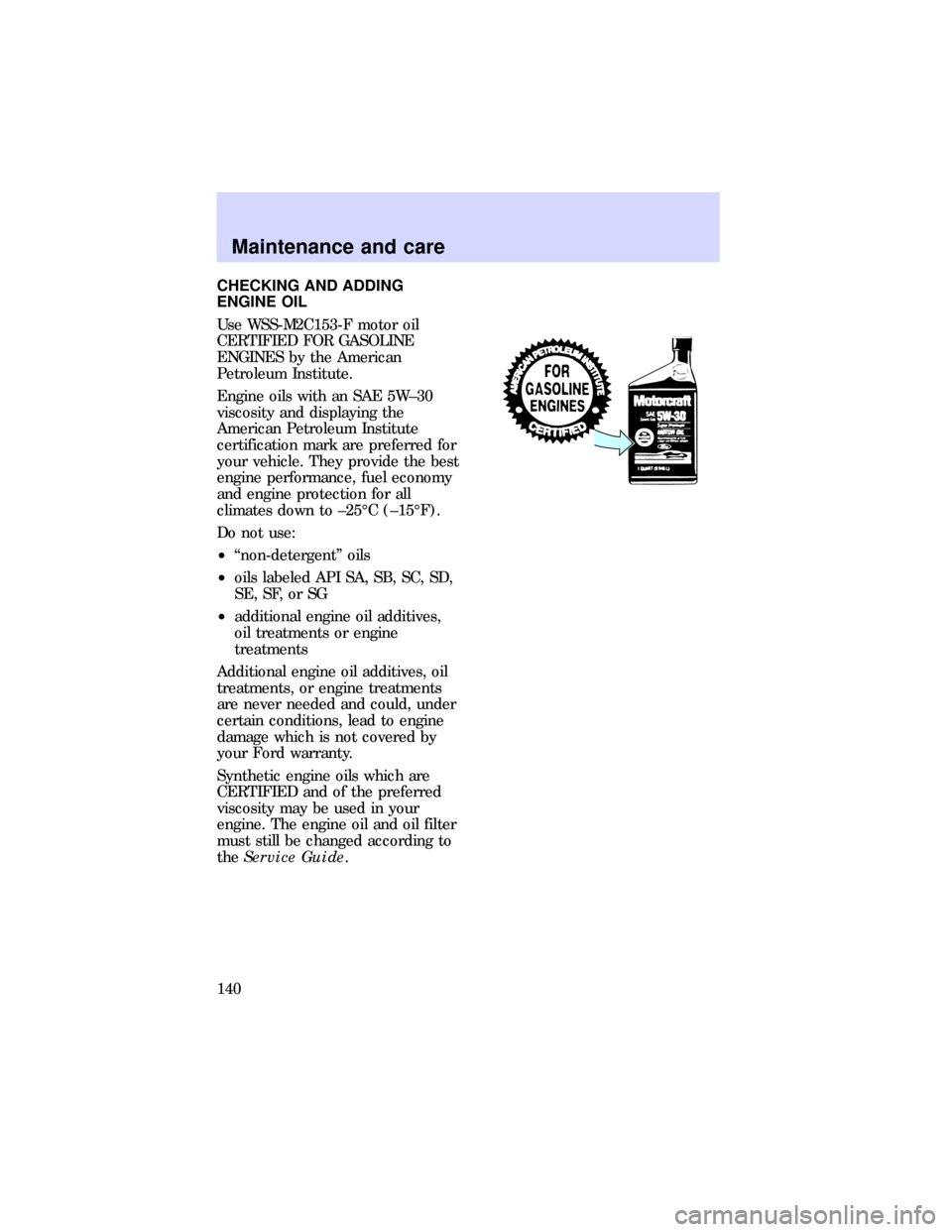
CHECKING AND ADDING
ENGINE OIL
Use WSS-M2C153-F motor oil
CERTIFIED FOR GASOLINE
ENGINES by the American
Petroleum Institute.
Engine oils with an SAE 5W±30
viscosity and displaying the
American Petroleum Institute
certification mark are preferred for
your vehicle. They provide the best
engine performance, fuel economy
and engine protection for all
climates down to ±25ÉC (±15ÉF).
Do not use:
²ªnon-detergentº oils
²oils labeled API SA, SB, SC, SD,
SE, SF, or SG
²additional engine oil additives,
oil treatments or engine
treatments
Additional engine oil additives, oil
treatments, or engine treatments
are never needed and could, under
certain conditions, lead to engine
damage which is not covered by
your Ford warranty.
Synthetic engine oils which are
CERTIFIED and of the preferred
viscosity may be used in your
engine. The engine oil and oil filter
must still be changed according to
theService Guide.
Maintenance and care
140
Page 141 of 197
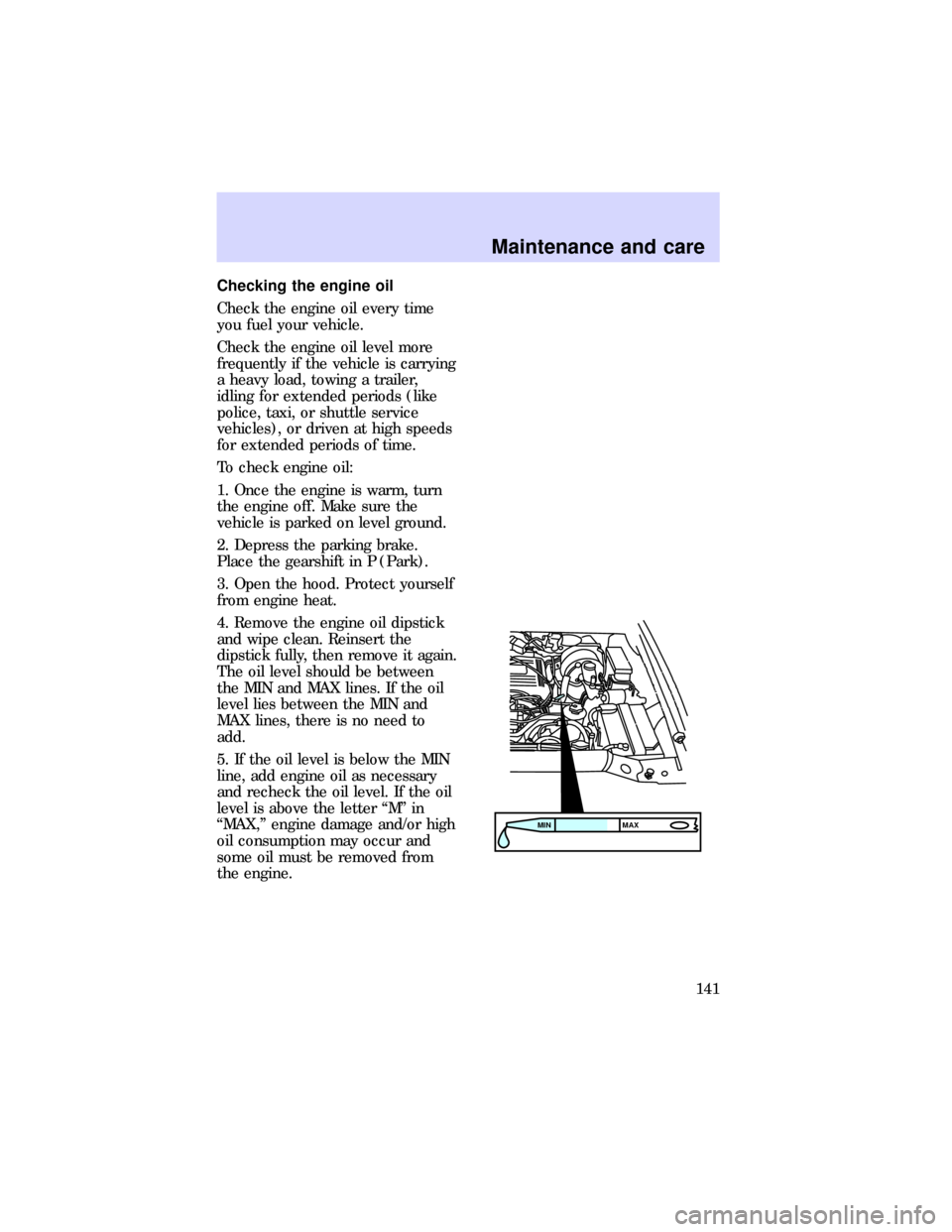
Checking the engine oil
Check the engine oil every time
you fuel your vehicle.
Check the engine oil level more
frequently if the vehicle is carrying
a heavy load, towing a trailer,
idling for extended periods (like
police, taxi, or shuttle service
vehicles), or driven at high speeds
for extended periods of time.
To check engine oil:
1. Once the engine is warm, turn
the engine off. Make sure the
vehicle is parked on level ground.
2. Depress the parking brake.
Place the gearshift in P (Park).
3. Open the hood. Protect yourself
from engine heat.
4. Remove the engine oil dipstick
and wipe clean. Reinsert the
dipstick fully, then remove it again.
The oil level should be between
the MIN and MAX lines. If the oil
level lies between the MIN and
MAX lines, there is no need to
add.
5. If the oil level is below the MIN
line, add engine oil as necessary
and recheck the oil level. If the oil
level is above the letter ``M'' in
``MAX,'' engine damage and/or high
oil consumption may occur and
some oil must be removed from
the engine.
MAX MIN
Maintenance and care
141
Page 142 of 197
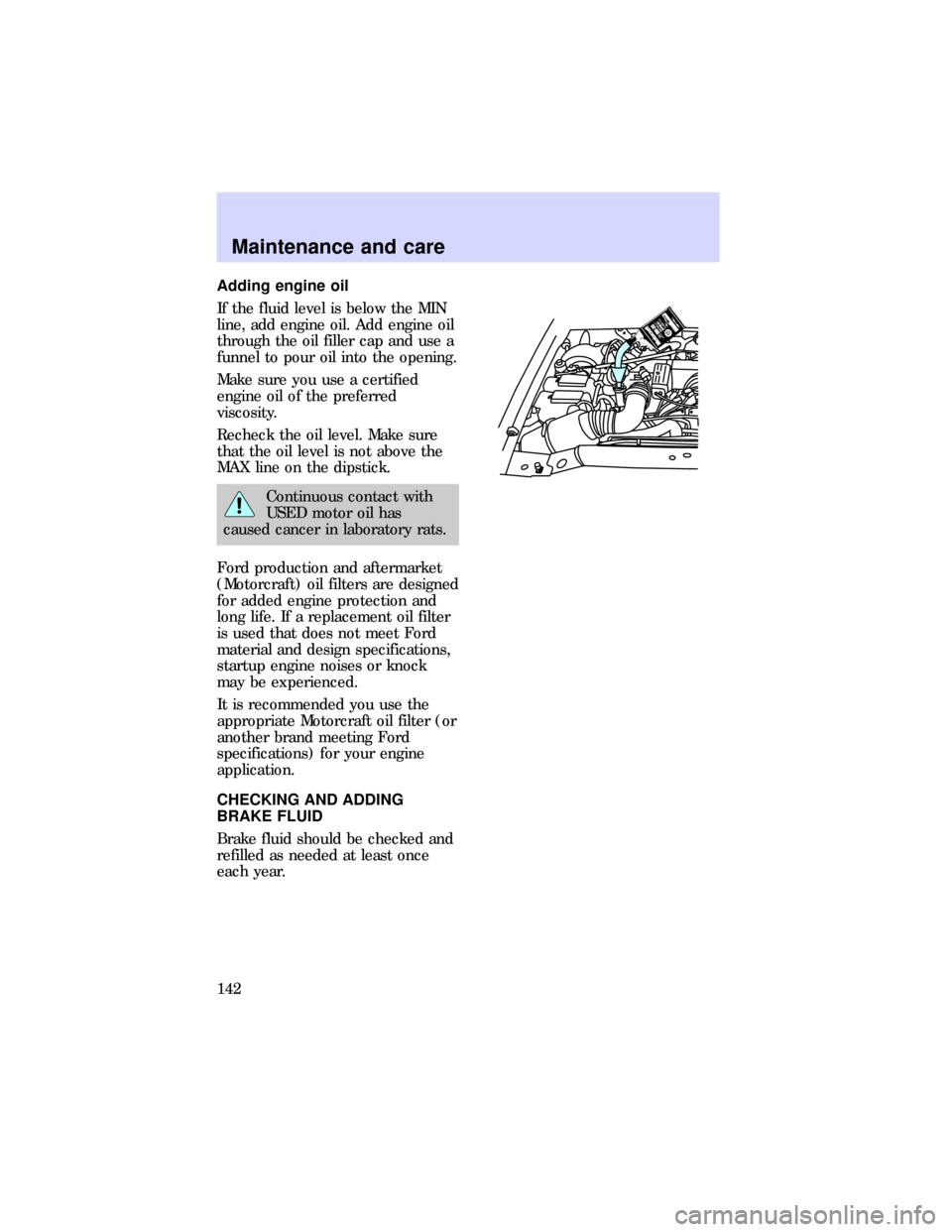
Adding engine oil
If the fluid level is below the MIN
line, add engine oil. Add engine oil
through the oil filler cap and use a
funnel to pour oil into the opening.
Make sure you use a certified
engine oil of the preferred
viscosity.
Recheck the oil level. Make sure
that the oil level is not above the
MAX line on the dipstick.
Continuous contact with
USED motor oil has
caused cancer in laboratory rats.
Ford production and aftermarket
(Motorcraft) oil filters are designed
for added engine protection and
long life. If a replacement oil filter
is used that does not meet Ford
material and design specifications,
startup engine noises or knock
may be experienced.
It is recommended you use the
appropriate Motorcraft oil filter (or
another brand meeting Ford
specifications) for your engine
application.
CHECKING AND ADDING
BRAKE FLUID
Brake fluid should be checked and
refilled as needed at least once
each year.
Maintenance and care
142
Page 145 of 197
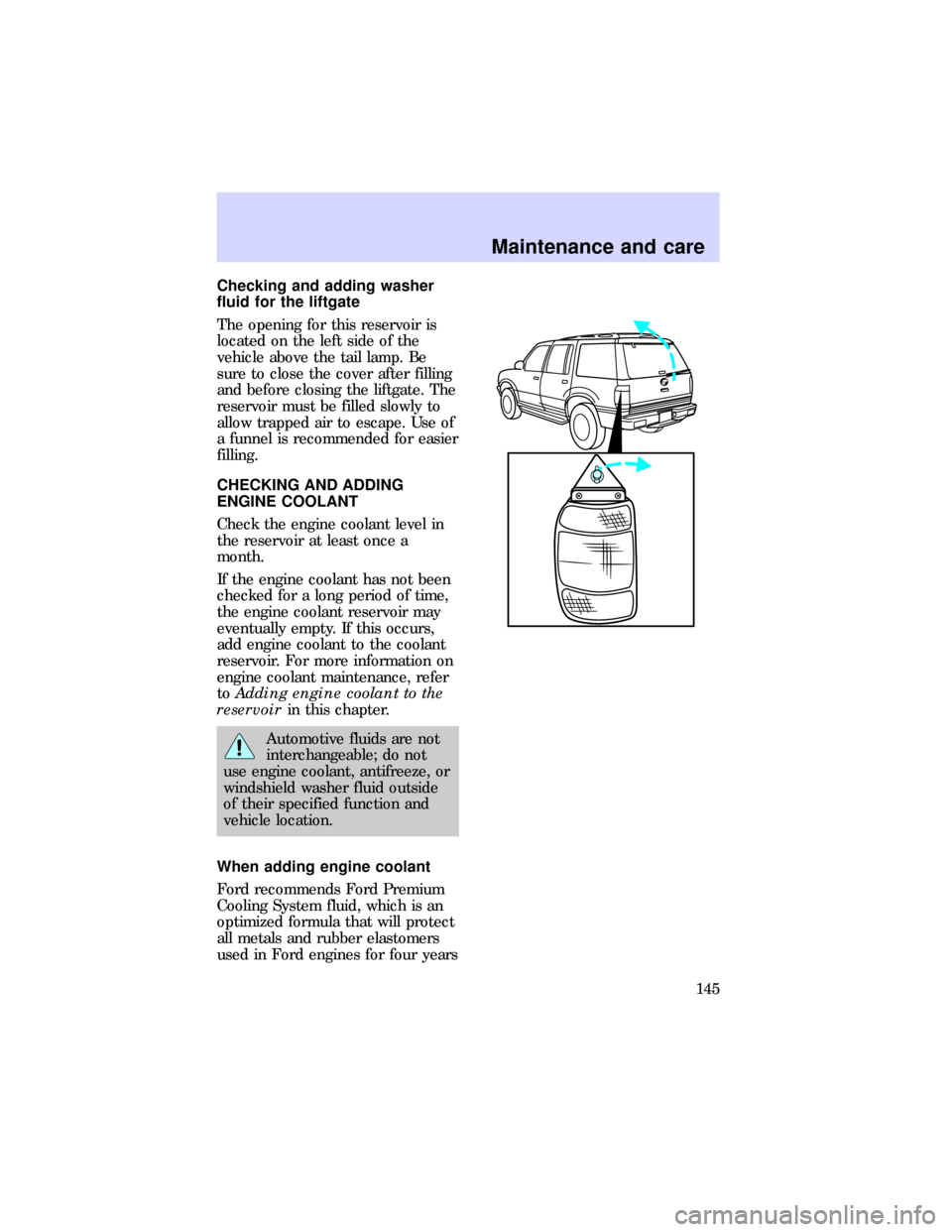
Checking and adding washer
fluid for the liftgate
The opening for this reservoir is
located on the left side of the
vehicle above the tail lamp. Be
sure to close the cover after filling
and before closing the liftgate. The
reservoir must be filled slowly to
allow trapped air to escape. Use of
a funnel is recommended for easier
filling.
CHECKING AND ADDING
ENGINE COOLANT
Check the engine coolant level in
the reservoir at least once a
month.
If the engine coolant has not been
checked for a long period of time,
the engine coolant reservoir may
eventually empty. If this occurs,
add engine coolant to the coolant
reservoir. For more information on
engine coolant maintenance, refer
toAdding engine coolant to the
reservoirin this chapter.
Automotive fluids are not
interchangeable; do not
use engine coolant, antifreeze, or
windshield washer fluid outside
of their specified function and
vehicle location.
When adding engine coolant
Ford recommends Ford Premium
Cooling System fluid, which is an
optimized formula that will protect
all metals and rubber elastomers
used in Ford engines for four years
Maintenance and care
145
Page 146 of 197
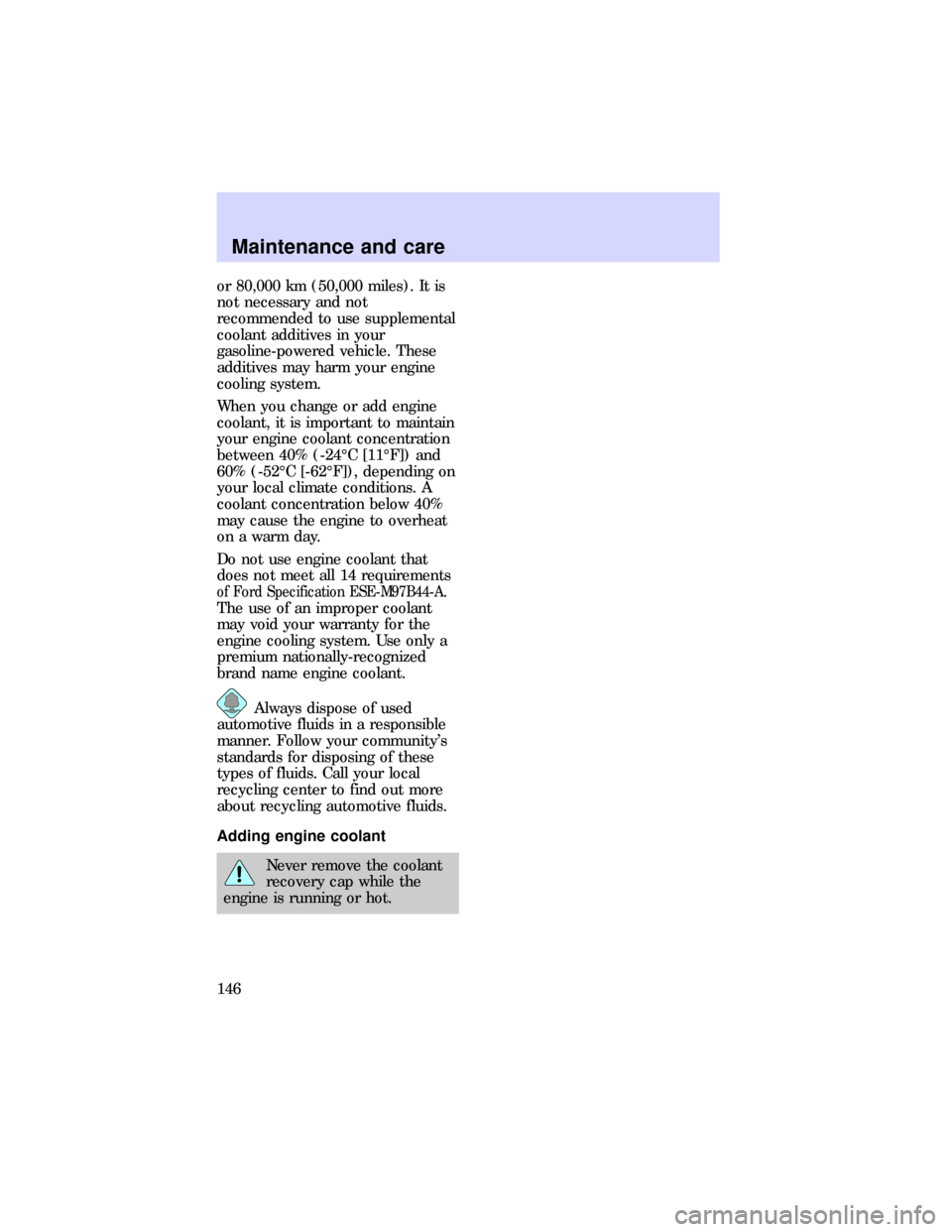
or 80,000 km (50,000 miles). It is
not necessary and not
recommended to use supplemental
coolant additives in your
gasoline-powered vehicle. These
additives may harm your engine
cooling system.
When you change or add engine
coolant, it is important to maintain
your engine coolant concentration
between 40% (-24ÉC [11ÉF]) and
60% (-52ÉC [-62ÉF]), depending on
your local climate conditions. A
coolant concentration below 40%
may cause the engine to overheat
on a warm day.
Do not use engine coolant that
does not meet all 14 requirements
of Ford Specification ESE-M97B44-A.
The use of an improper coolant
may void your warranty for the
engine cooling system. Use only a
premium nationally-recognized
brand name engine coolant.
Always dispose of used
automotive fluids in a responsible
manner. Follow your community's
standards for disposing of these
types of fluids. Call your local
recycling center to find out more
about recycling automotive fluids.
Adding engine coolant
Never remove the coolant
recovery cap while the
engine is running or hot.
Maintenance and care
146
Page 147 of 197

1. Before you remove the coolant
recovery cap, turn the engine off
and let it cool. Even when the
engine is cool, be careful when
removing the recovery cap. Wrap a
thick cloth around the cap for safe
removal.
2. When the engine is cool, lift the
cap.
3. Step back while pressure
releases.
4. When you are sure that all the
pressure has been released,
remove the recovery cap.
5. Stand away from the reservoir
opening; hot steam may blow out
or hot engine coolant may even
splash out.
6. Add engine coolant until the
level is between the MAX and MIN
lines on the engine coolant
recovery reservoir.
Follow the recommended service
interval for changing engine
coolant as outlined in theService
Guide. For coolant recovery
reservoir capacity, refer to
Lubricant specificationsin the
Capacities and specifications
chapter.
RADIATOR
COOLANT
ONLY
MAX
MIN
Maintenance and care
147
Page 148 of 197

Checking the cooling system
hoses
Before adding or replacing coolant,
inspect all cooling system hoses
for:
²deterioration
²leaks
²loose clamps
CHECKING AND ADDING
POWER STEERING FLUID
Check the power steering fluid at
least twice a year by completing
the following steps:
1. Start the engine.
2. When the engine coolant
temperature gauge reaches the
normal zone, turn off the engine.
CH
Maintenance and care
148